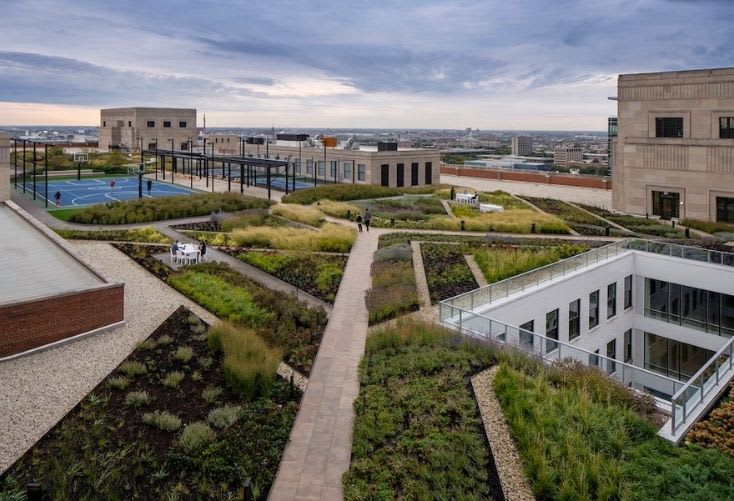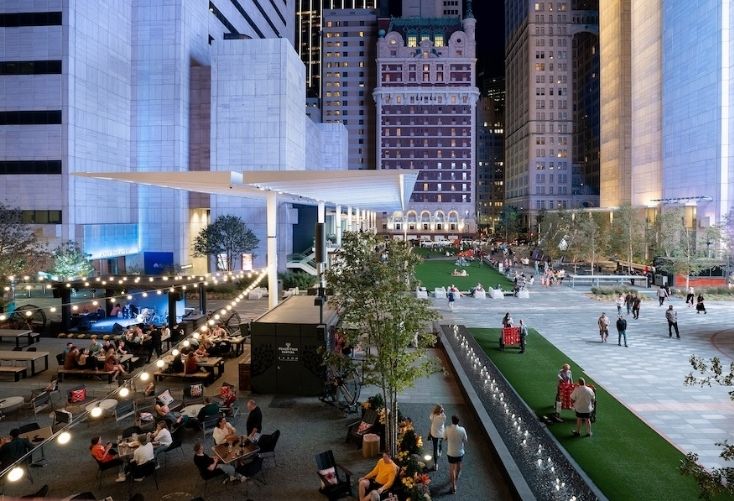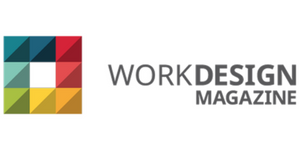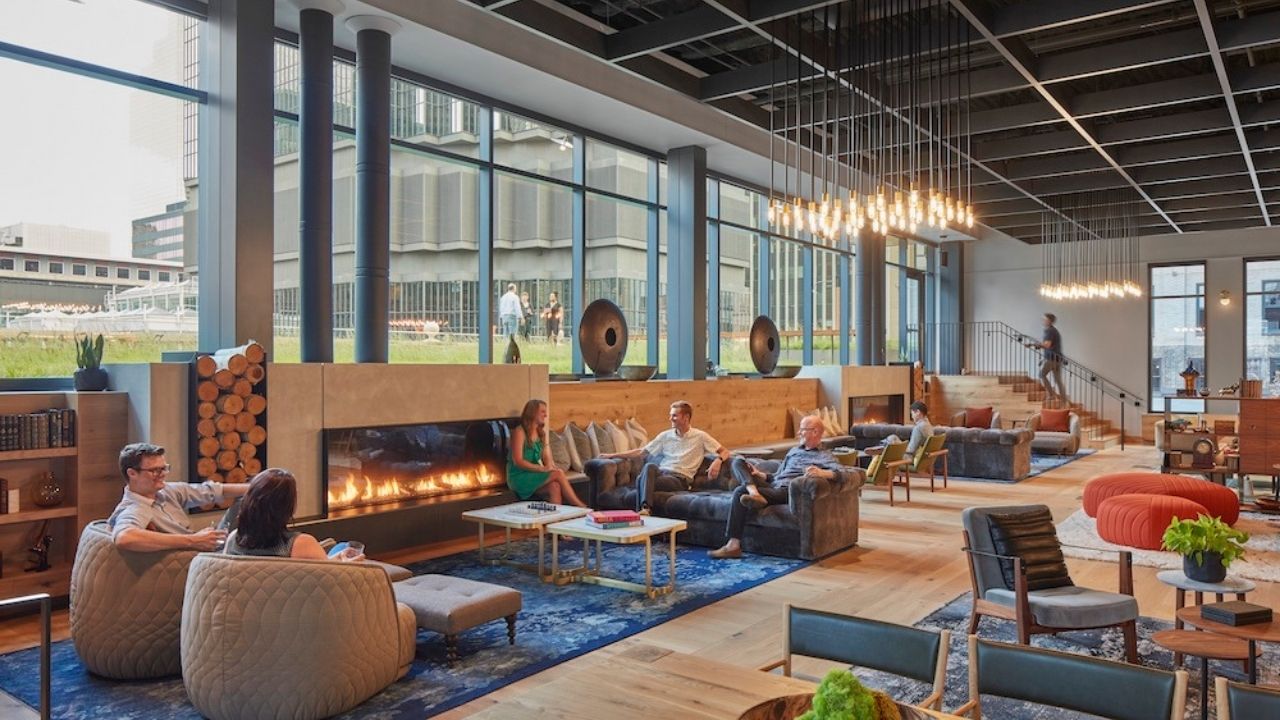- The physical workplace is where companies can best support the happiness, productivity, and overall well-being of their employees through culture.
- To thrive, urban workplaces need to address the changing expectations of its occupiers around three broad categories: wellness, experience, and environmental impact.
- Central business districts need to focus on livability and to provide what urban residents want from their downtowns – like less traffic, improved streetscapes, and access to green spaces.
This article was written by Ian Zapata and Sheryl Schulze, and was originally published on Work Design Magazine.
How we work has changed and the idea that a workplace must be contained in an office building has yielded to the notion that work is a mindset, not tied to any one location. The latest research tells us that people’s priorities for living and working are different, and flexible working is more important than being in a centralized location.
So, what does that mean for central business districts and their office buildings? The same research showed us that people want urban centers that are more than just good places to work, but also great places to live. This insight strongly suggests that the way forward for central business districts is to focus on livability and to provide what urban residents want from their downtowns like less traffic, improved streetscapes, and access to green spaces.
Data suggests that the physical workplace remains a critical asset. This is after all where companies can best support the health, happiness, productivity, and overall well-being of their employees through culture.
To thrive, urban workplaces need to address the changing expectations of tenants around three broad categories: wellness, experience, and environmental impact. Because most office space that will be used in the next three decades has already been built, much of it will have to be repositioned to better align with these demands.

Holistic Wellness
People crave social interaction and innovation is fueled by physical proximity, so the case for a central location to bond and collaborate is strong, but developers must be mindful that insular work destinations are the opposite of what people are looking for. With burnout and social isolation on the rise, people need places that will recharge their spirits and help them reconnect with the world around them. In other words, workers are prioritizing wellness and community in choosing where to work.
We can learn from the concept of “blue zones”, regions of the world where people are thought to live much longer than average due to healthy eating, active lifestyles, and community involvement. This trend was emphasized in recent successful repositioning projects which involved engaging and integrating with the surrounding community and fostering opportunities for social interaction.
Buildings that enable and support an active streetscape, access to social activities, and dining choices, can be thought of as conduits to a healthy engagement with a broader social circle. Older buildings may need to invest in advanced environmental controls that enable improved air quality and individual comfort, as well as high-quality outdoor spaces, the kind that are thoughtfully programmed and managed to be successful as extensions of the workplace. Take The Meadow at The Post Office in Chicago as an example. The Meadow is a 3.5-acre rooftop park on the 9th floor of this repositioned post office which now serves as a destination workplace. Programming includes a basketball court, pickleball courts, a walking path, and seasonal bar in addition to various modes of seating for working or lounging. The Meadow represents the next generation of tenant amenities, offering an evolved standard in access to outdoor spaces that allow for multiple modes of use.

Experience Matters
Repositioned office buildings must help alleviate the problems that remote work creates for employees such as monotony, social isolation, and the lack of boundaries. For employers, it can be productivity losses, the lack of alignment with company culture, and the erosion of bonds that come with long-distance relationships. No one wants to return to an uninspiring workplace and now, more than ever, the time spent at the office must be rewarding and memorable to engage workers and keep them coming back.
The repositioning of AT&T’s Headquarters in Dallas into The Discovery District is a great example of how a nice, but common workplace, can be transformed into an experiential destination that energizes the workforce and, in the process, also promotes community engagement. The project converted an underutilized plaza and surrounding streets into a dining and entertainment district connected by an immersive digital experience that transformed ordinary experiences like walking from the front door to an elevator into something that sparks wonder and joy. The AT&T Discovery District has become a valued asset to Dallas’s central business district and beyond through highly activated and immersive spaces for office tenants, and the public, to enjoy.
From our research data, we know that top-performing companies are three times as likely to increase their real estate footprint in the coming years due to the expectation that most of their staff will return to the office concurrently post-COVID, paired with their reliance on the office to support a wider range of activities. By reimagining the office as a destination rather than an obligation, and by creating a space that embodies company values and culture, companies can attract new hires while inviting existing team members back into an environment that truly prioritizes the human experience. To bring people back to business districts and cities should focus on what urban residents want from their downtowns.

Environmental Impact
The push to reduce an office building’s carbon footprint comes from two separate forces: Large corporate users are increasingly being pressed by their stockholders and customers to reduce their environmental impact, leading to ESG (environmental, social, and governance) initiatives that eventually translate into leasing decisions. The other force exerting pressure toward decarbonization is government regulation, which varies greatly between jurisdictions, but is trending to encourage more efficient buildings.
Remodeling an existing building will typically generate less embodied carbon – the carbon that goes into materials and construction – than a new building. However, existing buildings may not be as efficient when it comes to operational carbon, the kind that is released in a building’s daily operation, and this could make it difficult for a building to meet the latest energy codes.
Without significant investment in mechanical equipment upgrades and even the building’s envelope, such a building could, in the future, become a “stranded asset”, one that cannot be brought up to the standards the market demands in a financially viable way. In New York City, for example, sweeping new decarbonization regulations require buildings over 50,000 square feet to reduce their carbon emissions 40% by the year 2030 and 80% by 2050 or face annual fines.
Wellness, experience, and environmental impact are not independent of each other, in fact, there is synergy between them. For example, embracing micro-mobility helps to diminish congestion, promotes a healthier lifestyle, and reduces carbon emissions. Activating streetscapes and engaging the surrounding community can have a similar impact. Livability as a design strategy may very well be the difference between a successful repositioning and a future stranded asset. The question, “would I like to work here,” maybe as important to workers as, “would I want to live in a place like this?”
The collective impacts needed for the future state must begin to be solved for now. In the past two years, our lives have changed, and it’s now apparent that change is here to stay. Yet, design can and has offered solutions to many of the challenges we face. As cities prepare to tackle these challenges, design must be embraced to better human experiences, and urban work environments are a sensible place to start. There has been no other event in our lifetime that has provided the critical opportunity to influence our future. It would be a shame to waste it.


 Dr. Gleb Tsipursky – The Office Whisperer
Dr. Gleb Tsipursky – The Office Whisperer Nirit Cohen – WorkFutures
Nirit Cohen – WorkFutures Angela Howard – Culture Expert
Angela Howard – Culture Expert Drew Jones – Design & Innovation
Drew Jones – Design & Innovation Jonathan Price – CRE & Flex Expert
Jonathan Price – CRE & Flex Expert












